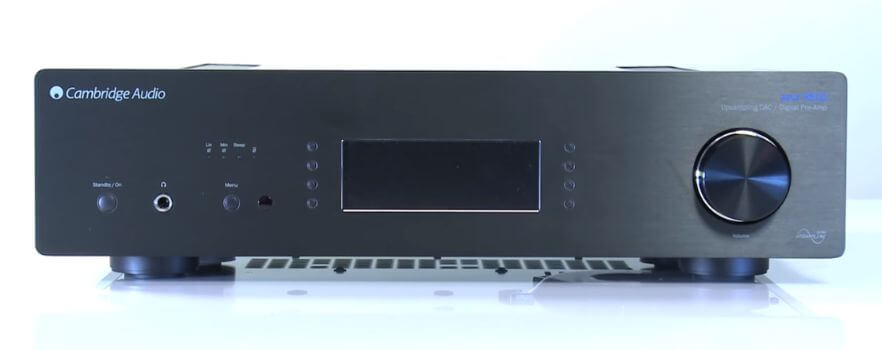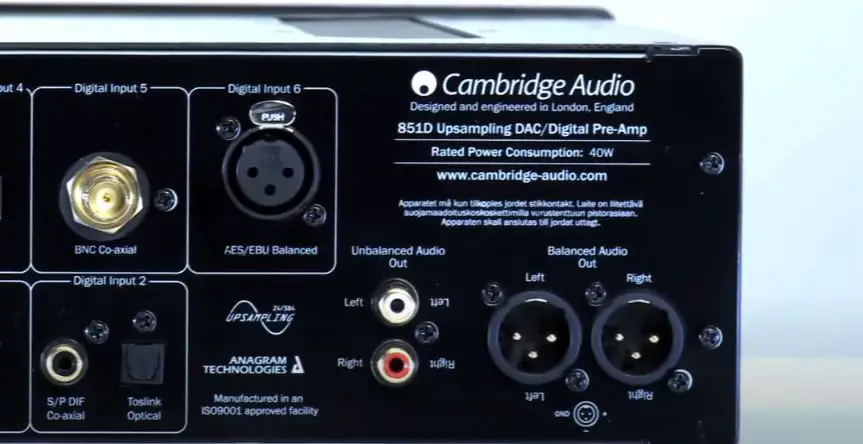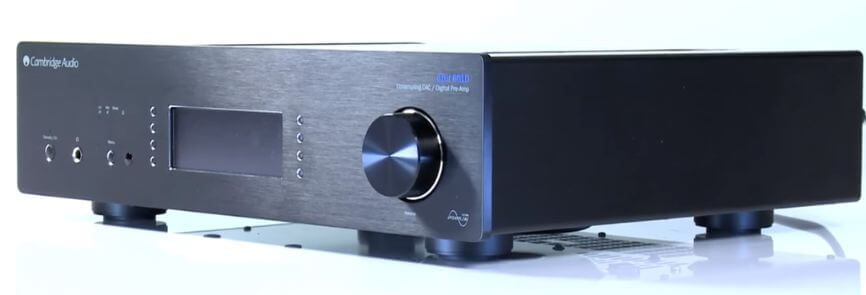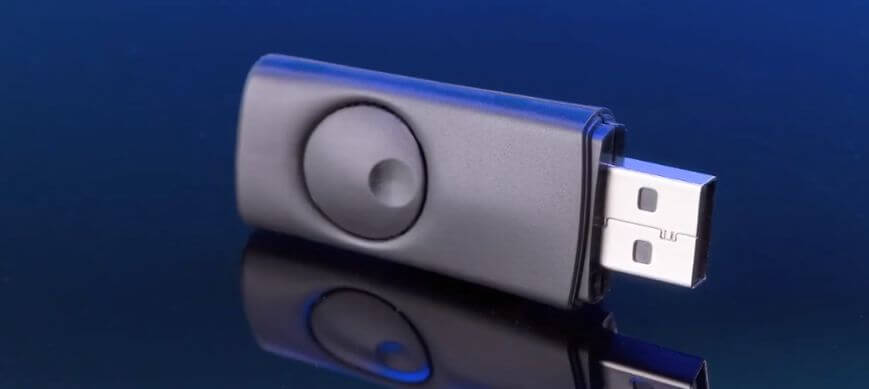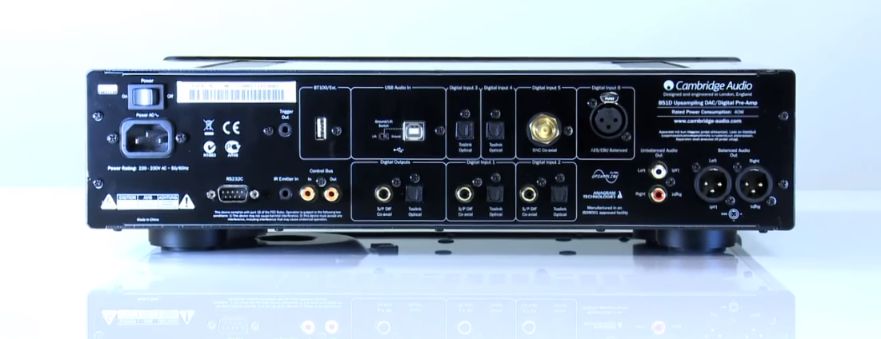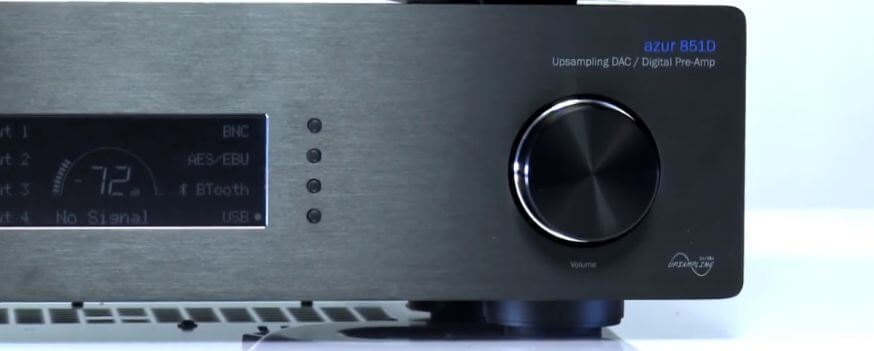Cambridge Audio 851D Review
Cambridge has always been one of my favourite audio company. Its design is excellent and never sensational. The quality and sound performance can not only be reflected in the price of the product but also often give me the joy of value for money. It is a company with a solid foundation and a company that understands consumer needs. However, is the money worth of what enthusiasts call Hi-End? After using and listening to the flagship 851 series 851D DAC preamp, I understand Cambridge Audio.
I know that Cambridge definitely has the ability to design Hi-End products, which can be used as a stepping stone to enter the Hi-End world.
Design
Azur 851 is Cambridge Audio’s flagship series. Its products lines are pretty complete, including 851A integrated amplifier, 851E preamplifier, 851W power amplifier, 851C CD turntable, and this 851D DAC. There are already 851E preamps in the 851 series, and the Azur 851D is positioned as a DAC digital converter. However, Cambridge Audio still gives the 851D the function of volume control, allowing the 851D to transfer signal to the power amplifier, allowing users to get the maximum potential and upgrade flexibility.
What kind of upgrade flexibility? For example, your audio system is like many beginners who just have a basic CD turntable with an integrated amplifier. If you have an idea of upgrading the system, you can choose the Azur 851D because its digital input can be connected to your CD turntable. You can also connect to a computer via USB for streaming.
The ATF2 upscaling technology of the Cambridge Audio Azur 851D can convert the input signal to a 24bit/384kHz format. The sound is naturally different. Furthermore, the 851D has a volume control. You can use the integrated amplifier as a power amplifier. And when you have a budget, you can upgrade to a pure power amplifier. If you still have a budget in the future and want to upgrade again, you can purchase the preamp. At this time, the Azur 851D will function to be a pure DAC.
The ideal audio system should be upgraded step by step and adjusted slowly. It is not an excellent way to achieve it overnight. The Cambridge Audio Azur 851D D/A processor allows users to gradually enjoy the fun and achievements of system evolvement during the upgrade process. Its strength is also enough to match more high-end peripheral equipment without frequent replacement.
The Digital Technology
The ATF2 technology that the Cambridge Audio 851D has, the second-generation Adaptive Time Filtering technology, is an algorithm jointly developed by Cambridge and Anagram of Switzerland. Through the BlackFin 32-bit DSP processor of Analog Devices, all input signals are upsampled to the frequency to 24bit / 384kHz format and then handed over to 2 AD1955 chips for digital conversion. ATF2 also provides three filter modes: Linear Phase, Minimum Phase and Steep to choose from.
Conveniently, the Cambridge Audio Azur 851D can directly switch the three filtering modes and the three inverted filtering modes through the remote control, making the operation more convenient. However, these six filtering modes are switched in sequence through a single button on the remote control. If you want to switch to the desired mode directly, you can operate it through the panel’s display.
In the analogue output and RCA, the 851D also has an XLR balanced output function. There is a 6.3mm headphone jack on the panel, which can be appropriately matched with headphones with an impedance of less than 300 ohms. 851D is a full-featured DAC, providing multiple digital input functions such as USB, TosLink, S/PDIF, BNC and AES/EBU. The TosLink only supports 24bit/96kHz, while the other digital inputs can reach 24bit/192kHz.
The 851D also has a Bluetooth wireless connection function, but you need to buy a BT100 Bluetooth receiver and plug it into the back panel to support A2DP plus aptX reception. The power supply of the Azur 851D is also quite particular with two power supplies. One is a high-efficiency switching power supply, and the other is a linear power supply composed of a large toroidal transformer. The toroidal transformer is also sealed with a metal cover to avoid magnetic leakage and vibration. The two sets of power supplies are supplied to the digital, analogue and control systems to prevent the interaction.
Easy to Operate
There is a single-colour LED display in the middle of the front panel, with four buttons on both sides, which can quickly perform all operations and controls, including input sources selection, filter mode switching, phase switching, left and right channel balance adjustment, display brightness adjustment, trigger Out function selection, and even the static time adjustment that automatically enters the standby mode.
You can choose to stand for 30 minutes, 1 hour or 2 hours, and then the Cambridge Audio 851D Reference DAC & Digital Preamp will automatically enter into the standby state to save power. With such a wealth of functions, most Hi-End models cannot provide these, but Cambridge takes it for granted. Besides, if you want to use USB 2.0 to listen to file format above 24bit/96kHz in Windows system, you need to install the driver, but Mac and Linux systems do not require it.
Sound Performance
The equipment included the Hegel H95 integrated amplifier in the sound performance testing, which drives the Klipsch RP-600M desktop speaker.
Before the testing, a decision must be made: let the 851D be a pure DAC or a DAC preamp? And Hegel H95 integrated amplifier, I can use both methods. After the AB comparison, I felt that turning on the preamp function of the 851D and going straight to the Klipsch RP-600M sounded more calm and smooth, so I decided to use it as a DAC preamp.
The first impression that the 851D gave me was that it was calm, relaxed and open, making me want to continue listening at a loud volume. Take the vinyl record selection CD provided to VIPs at the 2006 TAA Audio Show as an example.
Track 6 is Hugh Masekela’s “It Never Entered My Mind”. This delicate piece with the only trumpet, piano and double bass plucking are still fun to hear from the Cambridge Audio 851D because the three instruments each have their texture and details, making the sound appear natural and vivid, soft but direct, not dull.
Then I played Jennifer Warnes’s “The Well”. Although I rarely listen to this record, it is also an excellent recording and track record. The sound of 851D has another characteristic: it is very natural, especially when listening to the human voice. The whole music fluency is very smooth, sound just like a group of people chatting while listening to music.
Jennifer’s singing is naturally blended into the conversation between real people. Regardless of whether it is loud or quiet, gentle or fast, the transition between music changes is smooth, without a sense of abruptness. I’m sure such a particular kind and natural, high-resolution sound add significant value to the 851D.
Then it was the “Rava On the Dance Floor”, a live concert album that was a tribute to Michael Jackson, which was a collaboration between the Italian jazz trumpeter Enrico Rava and the Parco Della Musica Jazz Lab. The 851D showed that it could match the high-end models. It proves that it is the mastery of large sound pressure, complex music and scenes. That is a recording of a brass band concert.

The climax of the third track, “Thriller” is when everyone suddenly ends neatly. At this time, if you turn down the volume because you can’t stand the pressure of the sound, that means that the control of the system is insufficient. But the Cambridge Audio 851D did not allow such a situation to happen because it can play a well-defined, well-positioned sound field and an orderly structure. It has the strength of a high-end model to master the big scene.
Finally, I ended up with Kewei’s “Come colser with…”. When the music flows, I feel Cambridge Audio’s efforts to let consumers listen to music in a relaxing way because the singing voices that can be replay are so cordial and natural. There is no boasting rendering, but there is no lack of emotional infection. I know very well that what I hear is not a 100% perfect sound, but it is the kind of sound that allows people to listen comfortably without doubting whether there is a issue there.
Conclusion
The new flagship model of Cambridge Audio Azur 851 series, including Azur 851E pre-stage, Azur 851W post-stage, Azur 851D DAC. The three new cost-effective equipment allows users to assemble a high-quality audio system positioned in the mid-to-high-end market.
The Cambridge Audio Azur 851D DAC integrates Cambridge Audio’s many leading digital audio technologies. In addition to the traditional decoding interface, it also has a wealth of digital computer interfaces. The 851D has high-performance digital audio processing and upscaling technology and supports the decoding performance of high-quality audio streams. It adopts the new Analog Devices ADSP-BF532 32-bit DSP chip. It cooperates with the Anagram Technologies ATF2 decoding algorithm, which can reduce the time base error and provide high-quality digital filtering to achieve 24bit/192kHz up-conversion decoding capability. Azur 851D is a DAC worth buying.
Cambridge Audio 851D Specs
- DAC: Dual Analog Devices AD1955 24-bit DACs
- UPSAMPLING: Analog Devices Black Fin ADSP-BF532 32-bit DSP performing 2nd Generation ATF2 upsampling to 24-bit/384kHz. Linear phase, minimum phase or steep modes.
- DIGITAL INPUTS: S/PDIF, TosLink optical, BNC, AES/EBU, BT100 Bluetooth
- USB AUDIO INPUT: USB Type B conforming to Audio profile 1.0 or USB Audio profile 2.0 (user selectable) 1.0 or USB Audio profile 2.0 (user selectable)
- ANALOGUE AUDIO OUTPUTS: Balanced XLR and unbalanced RCA analogue audio outputs / 6.35mm headphone output (supports 600 Ohm headphones, 300 Ohms max recommended)
- SAMPLE RATES SUPPORTED: USB Audio 1.0 16-24 bit, 32-96kHz USB Audio 2.0 16-24 bit, 32-192kHz,TosLink 16-24 bit, 32-96kHz S/PDIF 16-24 bit, 32-192kHz BNC 16-24 bit, 32-192kHz AES/EBU 16-24 bit, 32-192kHz
- BT100 Bluetooth receiver: A2DP plus aptX
- MAXIMUM POWER CONSUMPTION: 40W
- COLOUR: Black or silver
- DIMENSIONS (HXWXD): 115 x 430 x 360mm (4.5 x 16.9 x 14.7”)
- WEIGHT: 7.5kg (16.5lbs)

